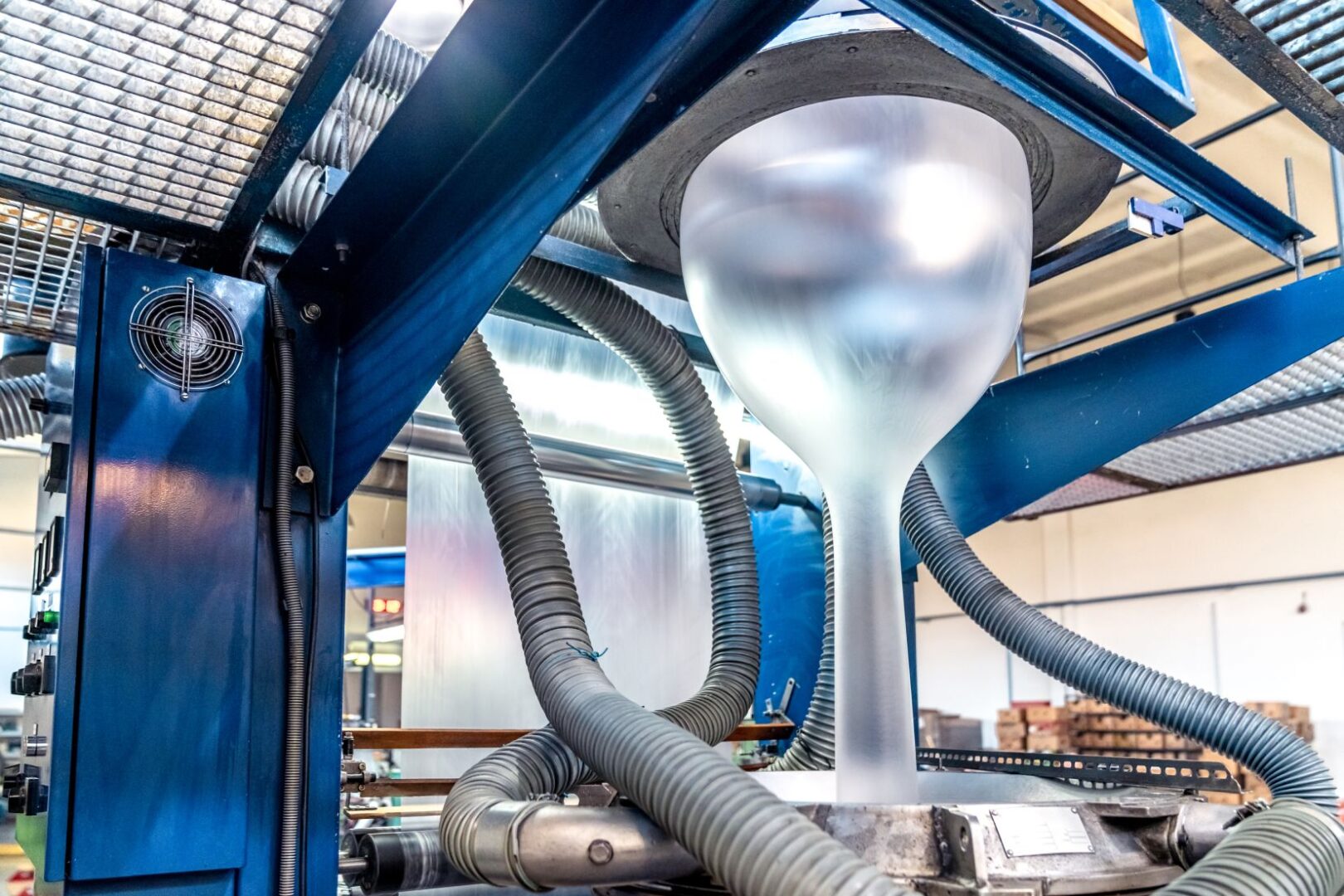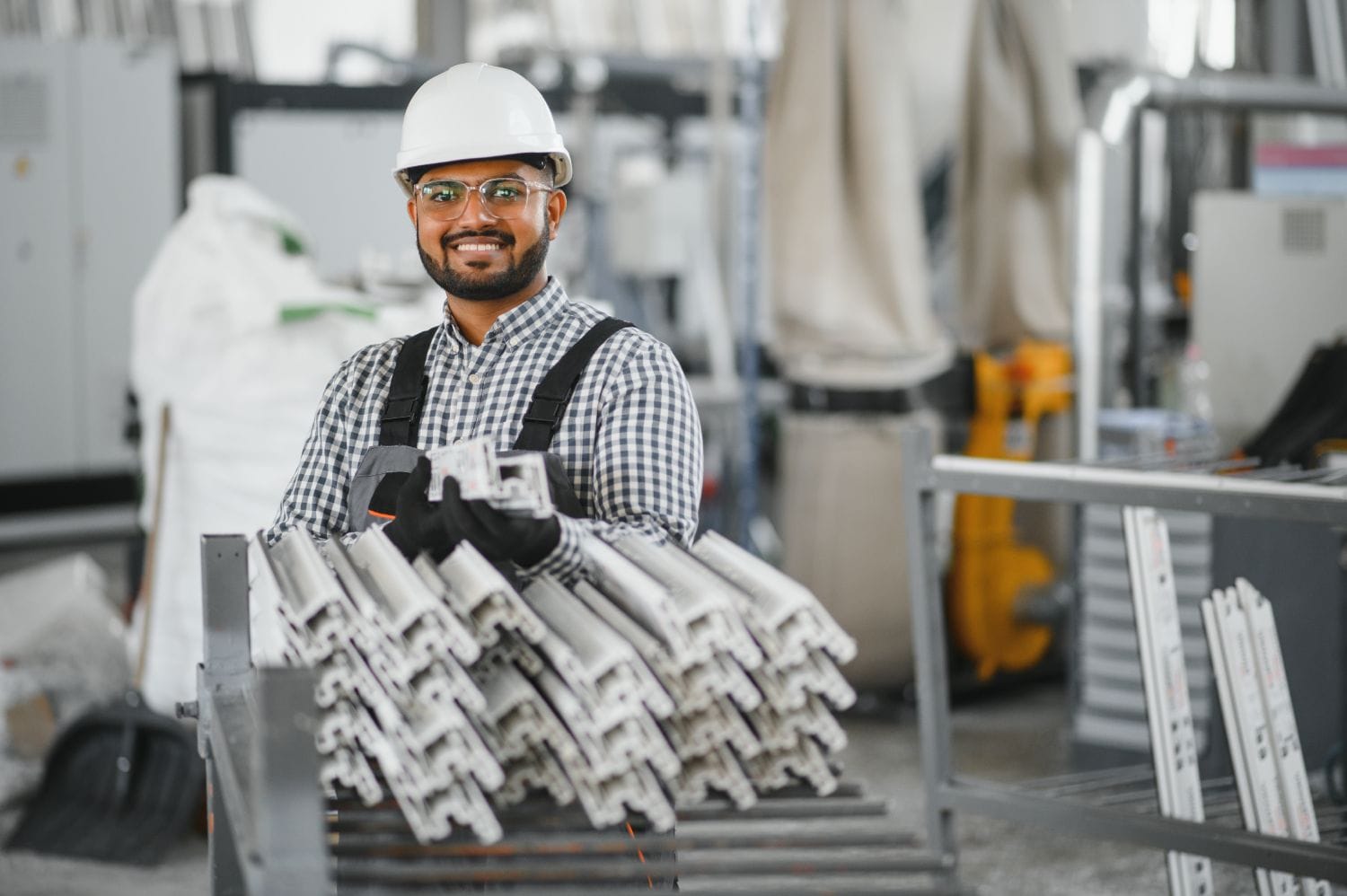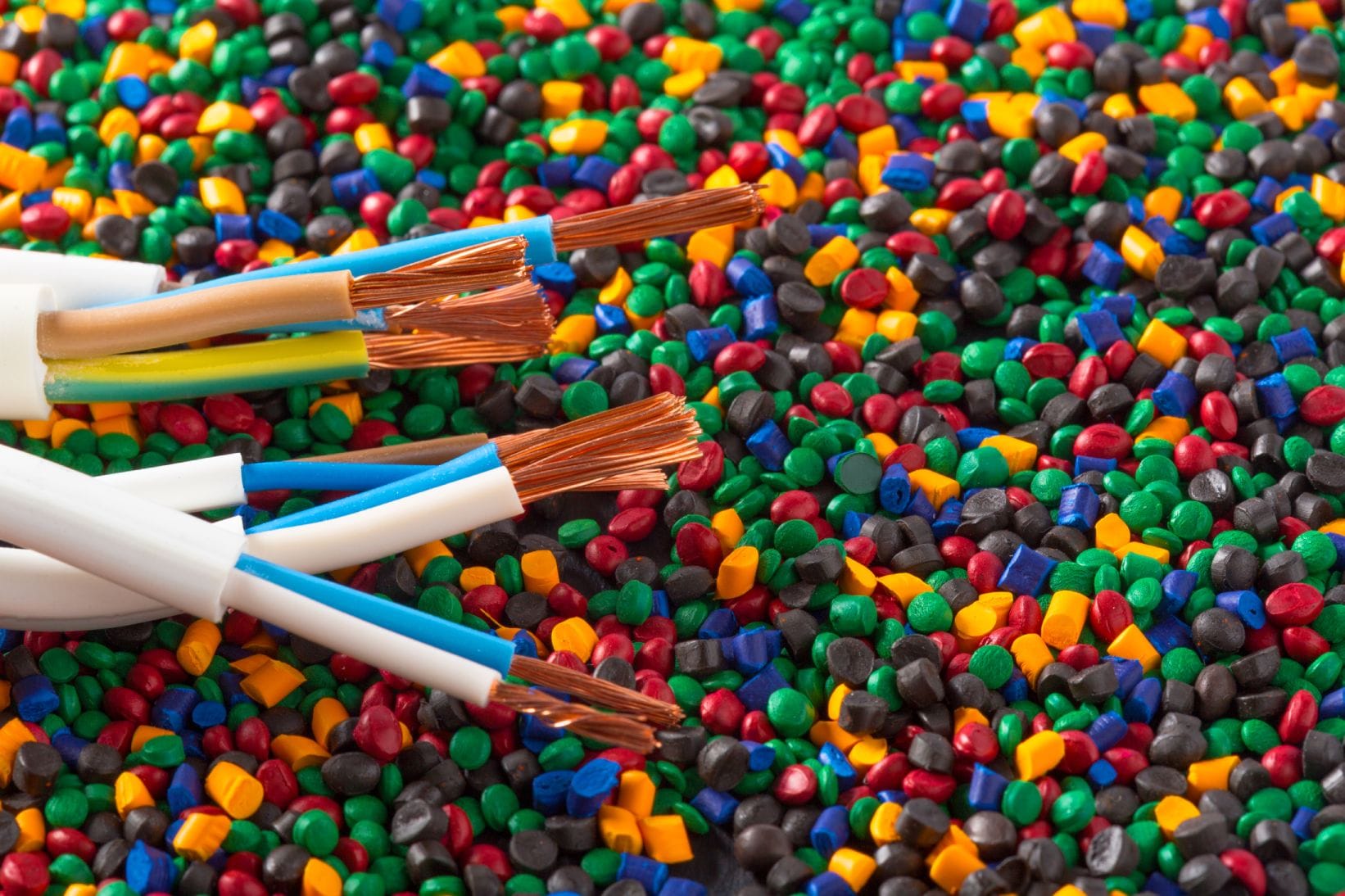Plastic plays a behind-the-scenes role in countless products we rely on every day. From the plastic tubing in medical devices to the window frames in our homes, this process is a driving force in manufacturing efficiency and innovation.
By converting raw plastic materials into long, continuous shapes, extrusion makes it possible to create everything from simple consumer products to highly technical components. It’s a method used to deliver precision, scalability, and value to clients across industries.
What Is Plastic Extrusion?
Plastic extrusion is a manufacturing process in which plastic resin—typically in the form of small pellets or granules—is melted and forced through a shaped die to produce a continuous profile.
The process is ideal for creating items that maintain a consistent cross-sectional shape along their length. For instance, products like PVC pipes, curtain rods, weather stripping, and plastic window frames are all commonly produced through extrusion.
Unlike molding processes that create individual items, extrusion is continuous, which allows manufacturers to produce long, uniform lengths of material that can be cut to size or used as is. This characteristic makes it particularly efficient for high-volume production.
How Does Plastic Extrusion Work?
Plastic extrusion is a carefully controlled, multi-stage process that transforms raw plastic materials into continuous, usable shapes. Each step is critical to ensuring the final product meets precise specifications in terms of shape, strength, and finish.
Here is a breakdown of each major stage in the extrusion process.
Step 1: Feeding the Raw Material
The process begins with loading raw plastic materials, often in the form of pellets or granules, into a hopper. The hopper acts as a funnel that supplies material into the extruder’s barrel at a steady rate.
Some systems include dryers or mixers at this stage to ensure the material is at the correct moisture level and properly blended for consistency.
Step 2: Melting the Plastic
Once inside the barrel, the plastic is gradually heated and melted by a combination of external heaters and the frictional force generated by a rotating screw. The screw moves the plastic forward through zones of increasing temperature.
This phase ensures the plastic is fully melted into a viscous liquid, ready to be shaped. Precise temperature control is important at this stage to prevent degradation of the material.
Step 3: Extruding Through the Die
The molten plastic is then pushed through a specialized die that determines the final shape of the product.
This die is custom-designed for each application to ensure the extruded material takes on the exact cross-sectional profile required, like a hollow tube or a complex window trim. This stage plays a central role in achieving dimensional accuracy.
Step 4: Cooling the Extrudate
As the plastic exits the die, it is still in a semi-molten state and must be quickly cooled to retain its shape. This process is typically accomplished using water baths or air cooling systems, depending on the material and application.
Cooling must be uniform and controlled to prevent warping, shrinkage, or surface imperfections.
Step 5: Pulling & Cutting
The solidified extrusion is then pulled through the cooling line by a puller, which ensures consistent speed and tension. Afterward, it is cut into specific lengths or rolled onto spools, depending on the product requirements.
This final step prepares the extruded plastic for packaging, secondary operations, or immediate use.

5 Types of Plastic Extrusion Processes
There are several specialized forms of the plastic extrusion process, each tailored to different product types and end uses. Understanding these variations is an important part of selecting the most suitable method for a specific application.
1. Tubing Extrusion
Tubing extrusion is used to produce hollow, cylindrical products such as medical tubing, drinking straws, and plumbing pipes. This process relies on a specialized die and a central mandrel to form and maintain the interior diameter of the tube as the plastic is extruded.
Precision control is critical with tubing extrusion to ensure uniform wall thickness and to meet tight dimensional tolerances, especially in applications where consistency and safety are vital.
2. Blown Film Extrusion
Blown film extrusion is commonly used to manufacture thin plastic films found in packaging, grocery bags, and agricultural sheeting.
During this process, molten plastic is extruded through a circular die and immediately inflated with air, forming a bubble-like tube. As the inflated film rises, it cools and collapses into flat layers before being wound onto rolls.
This method enables the production of thin, uniform films with controlled thickness and strong mechanical properties.
3. Sheet Film Extrusion
Sheet film extrusion is the process of creating wide, flat plastic sheets used in applications such as food containers, thermoformed packaging, and automotive interiors. In this method, the molten plastic is forced through a flat die and then passed over a series of cooling rollers. These rollers help determine the final thickness, texture, and surface quality of the sheet, allowing for high levels of customization depending on the end-use requirements.
4. Over-Jacketing Extrusion
Over-jacketing extrusion is designed to coat wires, cables, or fiber optic cores with a protective plastic layer. The core material is fed through the center of the extrusion die while molten plastic flows around it, forming a uniform and durable outer jacket.
This method is widely used in the electronics, telecommunications, and automotive industries to provide insulation, environmental protection, and mechanical strength.
5. Co-Extrusion
Co-extrusion involves using two or more extruders that feed different materials into a single die, producing a product with multiple distinct layers. This process allows manufacturers to combine materials with varied characteristics—such as rigidity and flexibility or clarity and color—into a single structure.
The co-extrusion process enhances both the performance and appearance of products. It’s ideal for packaging, tubing, and construction materials that require multifunctional properties.
Components of a Plastic Extruder
A plastic extruder is the heart of the extrusion process, serving as the machine that transforms raw plastic material into a finished shape. Each part of the extruder has a specific role in ensuring the process is efficient, consistent, and capable of producing high-quality outputs.
Hopper
The hopper is the entry point for raw plastic materials. It stores the pellets and feeds them into the barrel at a controlled rate and may include features like drying units or agitators to prepare the material before extrusion.
Barrel & Heater
The barrel houses the screw and is surrounded by heating elements. These heaters gradually raise the temperature of the plastic to its melting point as it travels through the barrel, ensuring uniform melting and minimizing material degradation.
Screw
The screw is a rotating component that conveys, compresses, and melts the plastic material. Its design—including length, pitch, and compression ratio—affects the efficiency and quality of the melting and mixing process.
Die
Attached to the end of the barrel, the die determines the shape of the extruded product. It must be precisely engineered to achieve accurate dimensions and smooth surface finishes, especially for complex profiles.
Cooling System
Once the plastic exits the die, it needs to be cooled to harden into its final shape. Water baths, air cooling units, or vacuum tanks may be used depending on the product type and material properties.
Puller & Cutter
The pulling and cutting components ensure the extruded plastic maintains a consistent speed and tension as it exits the die. The puller draws the extrusion through the cooling section, and the cutter trims it to the required lengths or formats for further use or packaging.
Types of Plastic Extruders
Plastic extruders are categorized based on the design and function of their screw mechanisms as well as the specific products they are intended to manufacture.
The choice of extruder depends on factors such as material composition, product complexity, throughput requirements, and end-use applications. To select the most suitable equipment for your production process, it’s important to understand the differences between extruder types.
Single-Screw Extruders
Single-screw extruders are the most widely used machines in the plastics industry and are best suited for straightforward applications involving a single material. These machines consist of one rotating screw housed inside a heated barrel, which melts and pushes the plastic material through a die. They are known for their simplicity, lower operational cost, and reliability in producing consistent, high-quality products.
Single-screw extruders are ideal for manufacturing items such as plastic tubing, sheeting, and solid profiles made from a uniform resin.
Twin-Screw Extruders
Twin-screw extruders utilize two intermeshing screws that rotate inside a common barrel, enabling more sophisticated material handling. These machines offer superior mixing, blending, and thermal control, making them suitable for applications that involve multiple resins, fillers, or additives. They are commonly used in compounding operations where fine control over shear and residence time is critical.
Although more expensive and complex to operate than single-screw models, twin-screw extruders provide enhanced versatility and precision for demanding industrial and specialty applications.
Co-Extrusion Machines
Co-extrusion machines are designed to extrude two or more different materials simultaneously through a single die to form multi-layered products. Each material is processed in a separate extruder, and their melt streams are combined just before exiting the die. This setup allows manufacturers to take advantage of different material properties, such as strength, flexibility, or barrier resistance, in a single product.
Co-extrusion is commonly used in packaging films, pipes with internal linings, and profiles that require a decorative or protective surface layer.
Blown Film Extruders
Blown film extruders are specialized systems used to produce thin plastic films commonly found in packaging and plastic bags. In this process, the molten polymer is extruded through a circular die and then inflated with air to form a tubular film bubble. The bubble is cooled, collapsed, and wound into rolls.
These machines are capable of producing films with uniform thickness and excellent strength-to-weight ratios. Blown film extrusion is especially useful for applications that require lightweight, flexible films with specific barrier or optical properties.
Flat Die Extruders
Flat die extruders are designed for producing wide, flat plastic sheets or films. The molten plastic is forced through a wide, narrow slit in the die, creating a continuous sheet that is then cooled and trimmed to the desired dimensions.
These extruders are commonly used in the manufacturing of thermoforming sheets, signage, and construction materials. The process allows for precise control over sheet thickness and surface finish, making it ideal for high-quality, dimensionally accurate flat products.
Plastic Extrusion Customization Capabilities
One of the greatest strengths of plastic extrusion is its adaptability. Unlike many other manufacturing methods, extrusion allows for a high level of customization at every stage of production.
Products can be customized by:
- Altering color, texture, and cross-sectional dimensions to match branding or performance requirements
- Incorporating functional additives for UV resistance, flame retardance, antimicrobial properties, or impact resistance
- Adding post-processing steps like punching, drilling, embossing, or custom printing to meet secondary functional or aesthetic needs
Additionally, custom die design options mean that even highly specialized geometries can be extruded with precision.

5 Common Plastic Extrusion Materials
Material selection plays an important role in the plastic extrusion process, as it directly affects the product’s strength, flexibility, appearance, and long-term performance. Each thermoplastic used in extrusion offers unique characteristics that make it more or less suitable for specific applications.
1. Polyvinyl Chloride (PVC)
PVC is a strong, versatile plastic commonly used in construction and industrial settings. It offers excellent resistance to moisture, chemicals, and UV radiation, so it is ideal for outdoor or structural applications.
Products such as window frames, conduit piping, and exterior siding often rely on PVC due to its durability, weather resistance, and relatively low cost.
2. Polyethylene (PE)
Polyethylene is a lightweight, flexible plastic known for its excellent impact resistance and chemical stability.
It is frequently used to manufacture films, plastic bags, containers, and flexible tubing. Its low cost and ease of processing make it a popular choice for both consumer and industrial products that require flexibility and durability.
3. Polypropylene (PP)
Polypropylene is a tough, fatigue-resistant material often selected for applications requiring chemical resistance and durability under stress. It performs well in higher-temperature environments and is commonly found in automotive components, laboratory equipment, and packaging solutions. Its low density contributes to lightweight product designs without compromising strength.
4. Polystyrene (PS)
Polystyrene is a rigid, transparent plastic that is valued for its clarity and ease of molding. While more brittle than other thermoplastics, it is a cost-effective option for many applications. It is commonly used in disposable utensils, CD and DVD cases, and insulation products. Its affordability and moldability make it a popular choice for lightweight packaging and general-purpose items.
5. Thermoplastic Elastomers (TPEs)
Thermoplastic elastomers combine the elastic flexibility of rubber with the easy processing of conventional thermoplastics. They are soft, stretchable, and resilient, making them ideal for products like seals, grips, overmolded parts, and soft-touch components.
TPEs are also recyclable, offering added environmental benefits alongside their performance advantages.
Advantages & Limitations of Plastic Extrusion
Plastic extrusion offers a wide array of benefits, especially for manufacturers looking to produce high volumes of consistent parts. However, like any manufacturing method, it also comes with a few limitations that must be considered when designing a product.
Advantages
Plastic extrusion is highly efficient for producing long, continuous products at scale.
- It is highly cost-effective for long production runs, helping manufacturers reduce unit costs.
- It is capable of producing complex cross-sections, allowing for design flexibility.
- It provides consistent quality and high efficiency, ensuring reliable, repeatable results.
Together, these advantages make plastic extrusion a powerful solution for manufacturers aiming to optimize both performance and production cost.
Limitations
While plastic extrusion is incredibly versatile, it is not suitable for every application.
- It is best suited for continuous profiles, not discrete parts, limiting product shape possibilities.
- Some complex geometries may require additional tooling or post-processing steps.
- Material compatibility may limit use in certain environments, particularly those requiring extreme heat or chemical resistance.
Understanding these limitations helps ensure that extrusion is applied appropriately and complemented by other manufacturing techniques when needed.
Frequently Asked Questions About Plastic Extrusion
What Is Plastic Extrusion?
Plastic extrusion is a manufacturing method that involves heating plastic material until it becomes pliable, then forcing it through a shaped die to create long, continuous forms. This technique is widely applied in the production of uniform items such as plastic pipes, tubing, window frames, films, and sheets. Its efficiency and ability to maintain consistent cross-sectional shapes make it ideal for large-scale production.
How Does Plastic Extrusion Work?
The plastic extrusion process begins by feeding plastic pellets or granules into a heated barrel through a hopper. Inside the barrel, a rotating screw moves the material forward while applying heat and pressure. As the plastic melts, it is pushed through a specially designed die that shapes it into the desired profile. Once the material exits the die, it is cooled (typically by air or water) before being cut to length or rolled for packaging.
What Is Plastic Extrusion Used for?
Plastic extrusion is used in a wide range of industries to manufacture products like pipes, hoses, insulation for electrical wires, weatherstripping, window and door frames, plastic films for packaging, and sheets used in construction or signage. The process is ideal for creating products with consistent shapes and long lengths.
What Is the Difference Between Plastic Extrusion & Injection Molding?
Plastic extrusion and injection molding are both methods of forming plastic, but they serve different purposes. Plastic extrusion is a continuous process used to create long, uniform shapes like tubing and sheets. Injection molding, on the other hand, is a cyclic process used to create discrete, often complex, three-dimensional objects like bottle caps or casings. In extrusion, plastic is pushed through a die, while in injection molding, it is injected into a mold cavity where it cools and solidifies before being ejected.
How Is Quality Controlled in the Plastic Extrusion Process?
Quality control in plastic extrusion involves monitoring key variables like temperature, screw speed, and pressure throughout the process to ensure consistency and performance. In addition to machine calibration, manufacturers use real-time measurement systems, such as laser gauges and sensors, to check dimensions and surface finish. Products may also undergo post-production inspections to verify strength, flexibility, and appearance.
What Are Some Challenges in Plastic Extrusion?
Challenges in plastic extrusion can include issues such as uneven material flow, surface imperfections, die buildup, or inconsistent wall thickness. These problems may arise from improper temperature control, equipment wear, or material impurities. Preventing these issues requires precise control of processing conditions, regular equipment maintenance, and the use of high-quality raw materials.
Is Plastic Extrusion Environmentally Friendly?
Plastic extrusion can be environmentally responsible when processes are optimized to reduce waste and energy use. Many manufacturers incorporate recycled materials into their operations, using regrind or post-consumer resins without compromising product quality. Closed-loop systems and improved process efficiency also contribute to minimizing the environmental impact of extrusion operations.
Contact Lakeland Plastics: The Leading Plastic Extrusion Company
Plastic extrusion is a versatile and efficient method for transforming raw polymers into a wide variety of usable products. With its cost advantages, customization capabilities, and broad applicability, extrusion continues to be a cornerstone of modern manufacturing.
At Lakeland Plastics, we not only provide the technology and expertise to bring plastic components to life but also offer the strategic partnership necessary for long-term success.
Whether you’re designing a new product or looking to optimize an existing one, we’re here to help. Our team is ready to collaborate with you on custom extrusion solutions that meet your exact needs—from concept to completion.
Contact us or request a quote today to discuss your project and discover how our expertise can move your vision forward.

